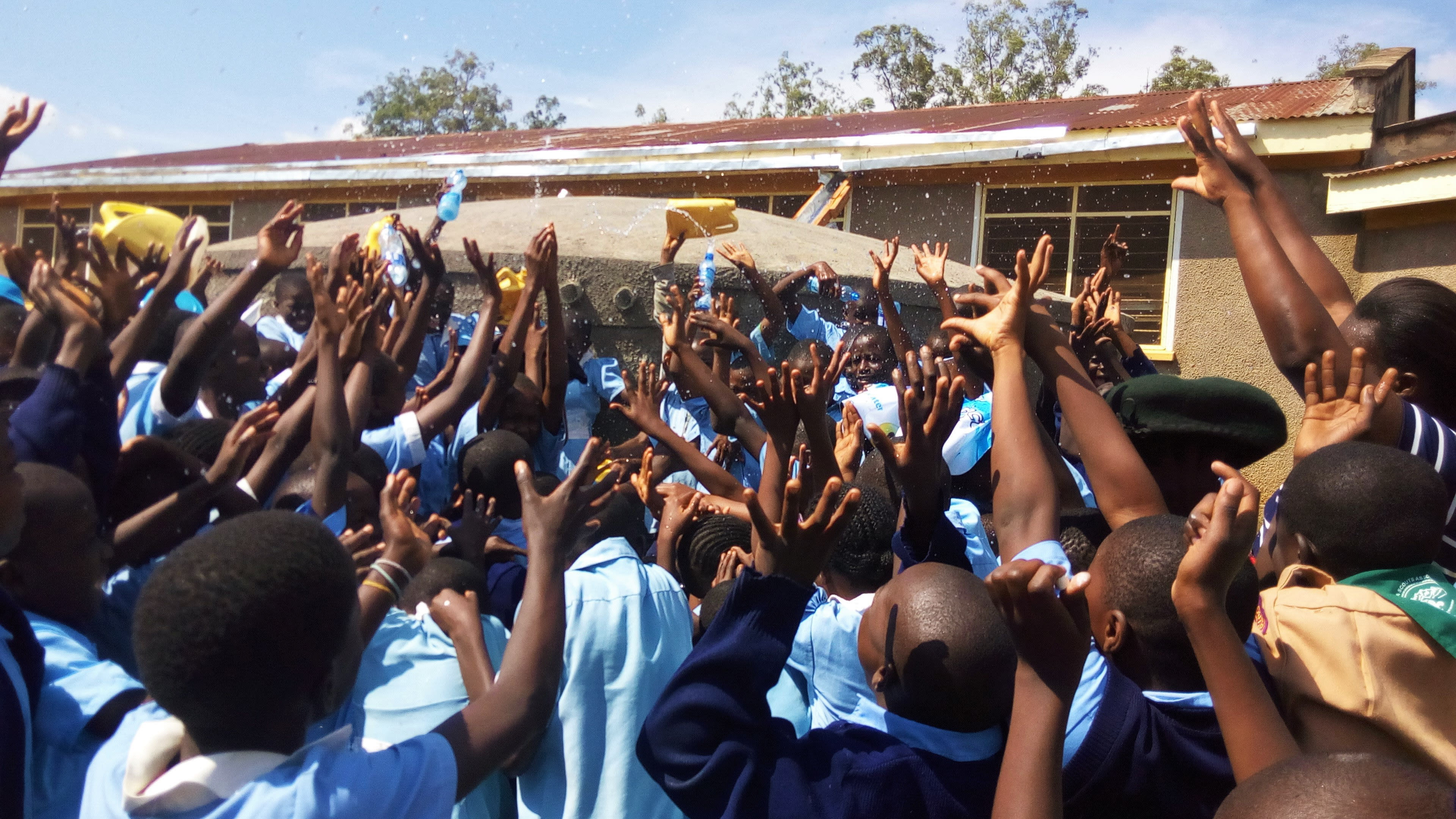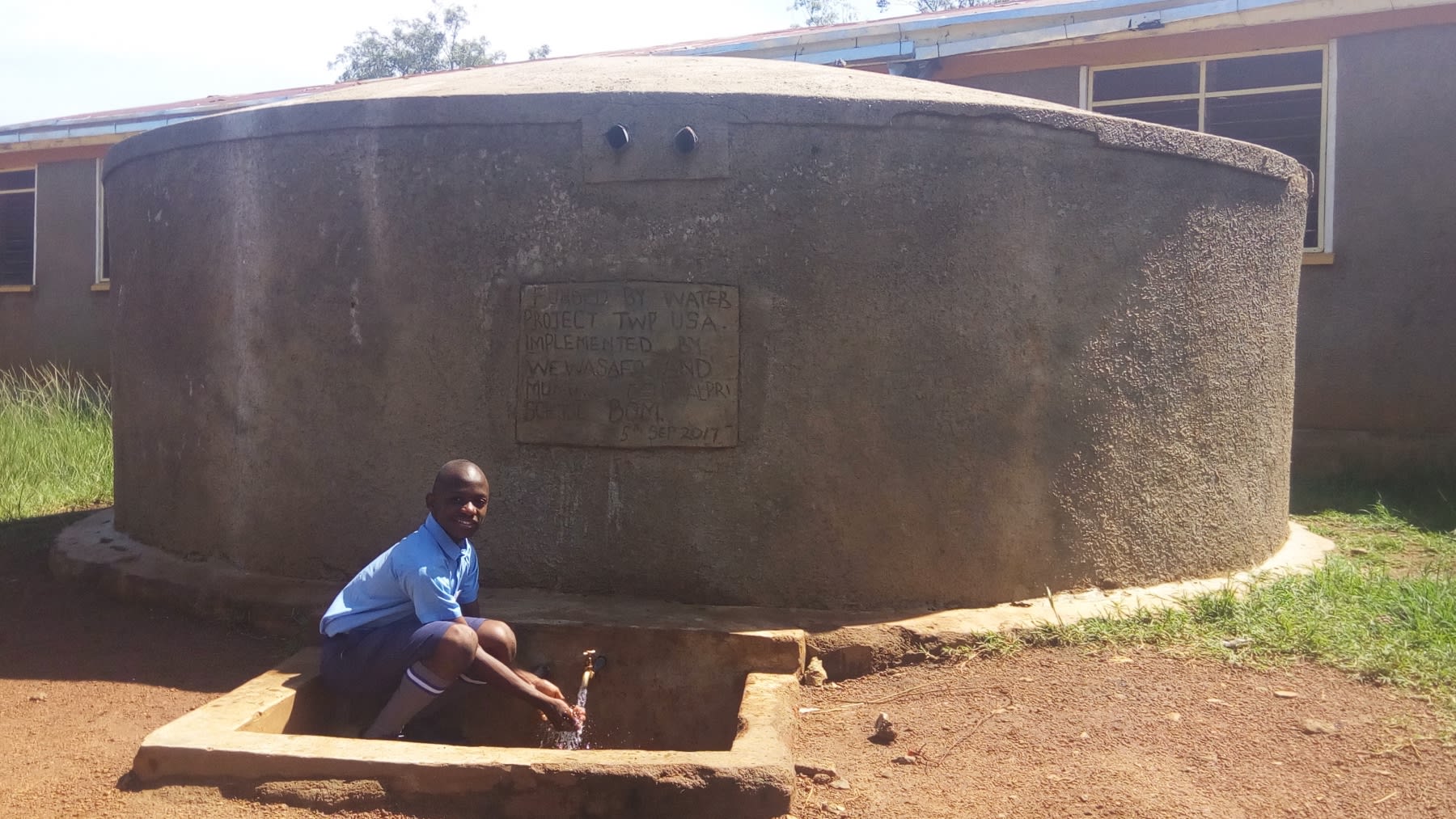This project is a part of our shared program with Western Water And Sanitation Forum (WEWASAFO). Our team is pleased to directly share the below report (edited for clarity, as needed).
Welcome to the School
It’s a Monday morning as the sun shines through the trees. At exactly 7 am, pupils start streaming through the gate in groups of three and five while others come alone. They are seen carrying their school bags on their backs with small water containers in their hands. As they enter the school gate, the school prefect checks them to ensure that they all have enough water. The prefect then allows them to take their water to the kitchen. Those who have no water are made to pick up rubbish as a punishment.
There are 1,901 students enrolled at Mumias Central. They are taught by 68 teachers and supported by 13 staff members. (Editor’s Note: While this many people may have access on any given day, realistically a single water source can only support a population of 350-500 people. This school would be a good candidate for a second project in the future so adequate water is available. To learn more, click here.)
This school was started in 1988 to provide a schooling option for the children of Mumias Sugar Company employees. The sugar factory built all of the infrastructure and then handed it over to the government.
Most people within this community are still sugarcane farmers who earn a living by selling sugarcane to the factory.
Water Situation
The school has two plastic water tanks of 1,200 liters each, which are not sufficient to serve such a massive population. Water is such a precious commodity within this school, and no one takes the task of fetching water lightly. The prefect knows that if a student doesn't bring their required water, the school won't have enough water to stay in session.
During the rainy season the pupils use 20-liter containers to fetch water directly from the storage tanks for cleaning and washing.
When they're thirsty, they bring their drinking cups to the tank.
During the dry season, students are required to carry containers of water from home. The school must also hire water tankers that cost 6,000 shillings each, which are emptied into the plastic water tanks. Between these two sources, the school barely gets by.
The school spends 6,000 Kenyan shillings for one tanker each week that it doesn't rain. This amounts to 24,000 shillings per month and a 72,000 shillings average per term (or about $700 USD) just to get enough water. This amount of money could have otherwise been used to improve the old infrastructure. When pupils are asked to come with a daily water supply, they often arrive late for morning preps - and this has affected their overall performance. At times students are sent out to get more water from nearby sources with poor water quality, and cases of diarrhea, headaches and stomachaches are not uncommon.
"My name is Mr. Francis Omwamu. I am the headteacher of Mumias Central Primary School. My greatest challenge has been to get safe and clean water for this great population of 1901 pupils. We've spent a lot of money that would otherwise have improved our school infrastructure. On many occasions we send pupils to get water from homes as they come, and at times we are not sure about the quality."
Sanitation Situation
There are 12 fully functional pit latrines for these 1,901 students. There are another eight that are falling apart and almost full though still being used by students. There are no hand-washing stations here, though there is a dish rack near the kitchen for the students to dry their drinking cups.
Though all of these facilities are heavily overused, they school does their best to keep them clean.
Plans: Hygiene and Sanitation Training and Hand-Washing Stations
Training will be held for three days. The facilitator will use PHAST (participatory hygiene and sanitation transformation), ABCD (asset-based community development), CTC (child to child), lectures, group discussions, and handouts to teach health topics and ways to promote good practices within the school. The CTC method will prepare students to lead other students into healthy habits, as well as kickstart a CTC club for the school. This CTC club will oversee the new facilities, such as hand-washing stations, and make sure they are kept clean and in working condition. The two hand-washing stations will be delivered to the school, and the club will fill them with water on a daily basis and make sure there is always a cleaning agent such as soap or ash.
Plans: Rainwater Catchment Tank
A 50,000-liter rainwater catchment tank will be constructed on school grounds. Teachers, students, and parents will gather the materials needed for this project, including sand, ballast, bricks, and hardcore. This contribution will fuel a sense of responsibility for the school and community to take care of their new facilities. Once materials are mobilized, the WEWASAFO team will arrive to lead the construction effort.
With adequate clean water, the school will have water for drinking, cooking, cleaning, and hand-washing. The school will no longer have to rely on the small amounts of (often contaminated) water carried by students, nor will they have to spend so much to have water delivered by tankers.
Plans: VIP Latrines
Two triple-door latrines will be constructed, providing three new latrines for each gender. Latrine materials will be mobilized the same way as the tank, ensuring the school feels these facilities are truly theirs. And with a rainwater catchment tank nearby, there will be enough water to keep them clean.
School administration and parents are positive that with these new facilities and training, their students’ academic performance will improve. Students will be healthy and empowered to focus on what’s important!

 Rainwater Catchment
Rainwater Catchment
 Rehabilitation Project
Rehabilitation Project





































